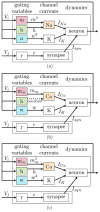Biophysical Neural Spiking, Bursting, and Excitability Dynamics in Reconfigurable Analog VLSI
- PMID: 22227949
- PMCID: PMC3251010
- DOI: 10.1109/TBCAS.2011.2169794
Biophysical Neural Spiking, Bursting, and Excitability Dynamics in Reconfigurable Analog VLSI
Abstract
We study a range of neural dynamics under variations in biophysical parameters underlying extended Morris-Lecar and Hodgkin-Huxley models in three gating variables. The extended models are implemented in NeuroDyn, a four neuron, twelve synapse continuous-time analog VLSI programmable neural emulation platform with generalized channel kinetics and biophysical membrane dynamics. The dynamics exhibit a wide range of time scales extending beyond 100 ms neglected in typical silicon models of tonic spiking neurons. Circuit simulations and measurements show transition from tonic spiking to tonic bursting dynamics through variation of a single conductance parameter governing calcium recovery. We similarly demonstrate transition from graded to all-or-none neural excitability in the onset of spiking dynamics through the variation of channel kinetic parameters governing the speed of potassium activation. Other combinations of variations in conductance and channel kinetic parameters give rise to phasic spiking and spike frequency adaptation dynamics. The NeuroDyn chip consumes 1.29 mW and occupies 3 mm × 3 mm in 0.5 μm CMOS, supporting emerging developments in neuromorphic silicon-neuron interfaces.
Figures











Similar articles
-
Analog VLSI Biophysical Neurons and Synapses With Programmable Membrane Channel Kinetics.IEEE Trans Biomed Circuits Syst. 2010 Jun;4(3):139-48. doi: 10.1109/TBCAS.2010.2048566. IEEE Trans Biomed Circuits Syst. 2010. PMID: 23853338
-
Assimilation of Biophysical Neuronal Dynamics in Neuromorphic VLSI.IEEE Trans Biomed Circuits Syst. 2017 Dec;11(6):1258-1270. doi: 10.1109/TBCAS.2017.2776198. IEEE Trans Biomed Circuits Syst. 2017. PMID: 29324422
-
Biophysical synaptic dynamics in an analog VLSI network of Hodgkin-Huxley neurons.Annu Int Conf IEEE Eng Med Biol Soc. 2009;2009:3335-8. doi: 10.1109/IEMBS.2009.5333272. Annu Int Conf IEEE Eng Med Biol Soc. 2009. PMID: 19964071
-
Neuromorphic silicon neuron circuits.Front Neurosci. 2011 May 31;5:73. doi: 10.3389/fnins.2011.00073. eCollection 2011. Front Neurosci. 2011. PMID: 21747754 Free PMC article.
-
Orientation-selective aVLSI spiking neurons.Neural Netw. 2001 Jul-Sep;14(6-7):629-43. doi: 10.1016/s0893-6080(01)00054-5. Neural Netw. 2001. PMID: 11665759 Review.
Cited by
-
An FPGA Platform for Real-Time Simulation of Spiking Neuronal Networks.Front Neurosci. 2017 Feb 28;11:90. doi: 10.3389/fnins.2017.00090. eCollection 2017. Front Neurosci. 2017. PMID: 28293163 Free PMC article.
-
Memristive Izhikevich Spiking Neuron Model and Its Application in Oscillatory Associative Memory.Front Neurosci. 2022 May 3;16:885322. doi: 10.3389/fnins.2022.885322. eCollection 2022. Front Neurosci. 2022. PMID: 35592261 Free PMC article.
-
A neuromorphic network for generic multivariate data classification.Proc Natl Acad Sci U S A. 2014 Feb 11;111(6):2081-6. doi: 10.1073/pnas.1303053111. Epub 2014 Jan 27. Proc Natl Acad Sci U S A. 2014. PMID: 24469794 Free PMC article.
References
-
- Satyanarayana S, Tsividis YP, Graf HP. A reconfigurable VLSI neural network. J Solid State Circuits. 1992 Jan;27(1):67.
-
- Indiveri G, Chicca E, Douglas R. A VLSI array to low-power spiking neurons and bistable synapses with spike-timing dependent plasticity. IEEE Trans Neural Netw. 2006 Jan;17(1):211–221. - PubMed
-
- Simoni MF, Cymbalyuk GS, Sorensen ME, Calabrese RL, DeWerth SP. A multiconductance silicon neuron with biologically matched dynamics. IEEE Trans Biomed Eng. 2004 Feb;51(2):342–354. - PubMed
-
- Simoni MF, DeWerth SP. Two-dimensional variation of bursting properties in a silicon-neuron half-center oscillator. IEEE Trans Neural Syst Rehabil Eng. 2006 Sep;14(3):281–289. - PubMed
-
- Vogelstein RJ, Mallik U, Vogelstein JT, Cauwenberghs G. Dynamically reconfigurable silicon array of spiking neurons with conductance-based synapses. IEEE Trans Neural Netw. 2007 Jan;18(1):253–265. - PubMed

